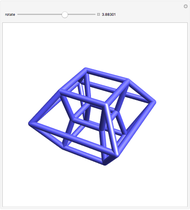

Although the orthographic views seem harder to understand, they will help us to interpret the views of the hypercube in the movie below. Now we shrink the colored edges down to simple, black edges, and follow the rotations again in reverse. Note that both the closest and farthest corners appear at the center of the hexagon. This, too, is an unexpected view of the cube.

In the orthographic view, we see a hexagon crossed by six lines meeting at the center.

We stop rotating at a view where we are looking directly at an edge of the cube a picture we might never have considered to be a view of a cube.īefore moving to the next rotation, we back up just a bit to make it easier to see the different faces of the cube, and then rotate the cube in a different direction, and end up looking directly at the corner of the cube (along its long diagonal). This is the "revolving door" illusion, in which we seem to see squares moving past each other. If you track the colors carefully, you can see which parts of the two-dimensional shadow correspond to which faces of the cube. The view on the left shows the rotation clearly, but we have to think harder about the rotation on the right. The remaining four sides appear as trapezoids in the perspective view but, in the orthographic view, they are flattened out to simple line segments, since these sides are parallel to our line of sight.Īs the movie continues, the cube rotates. In the perspective view, you see a square within a square (the front face is a large square, and the back face is a smaller square) in the orthographic view, however, the front and back squares are the same size, and are one on top of the other, so you seem to see only one square. We begin with a view that you recognize as a view of a cube, and then rotate so that you are looking directly at a face of the cube. The orthographic view is what you would see as a shadow cast from a light source that is infinitely far away (so that the light rays are parallel), while the perspective view comes from a light source that are finitely far away, so that the light rays are diverging. This movie shows two projections of a cube: on the left, the view is in perspective, where parts that are farther away are smaller on the the right is an orthographic view, where items are always the same size no matter how far away they are.


 0 kommentar(er)
0 kommentar(er)
